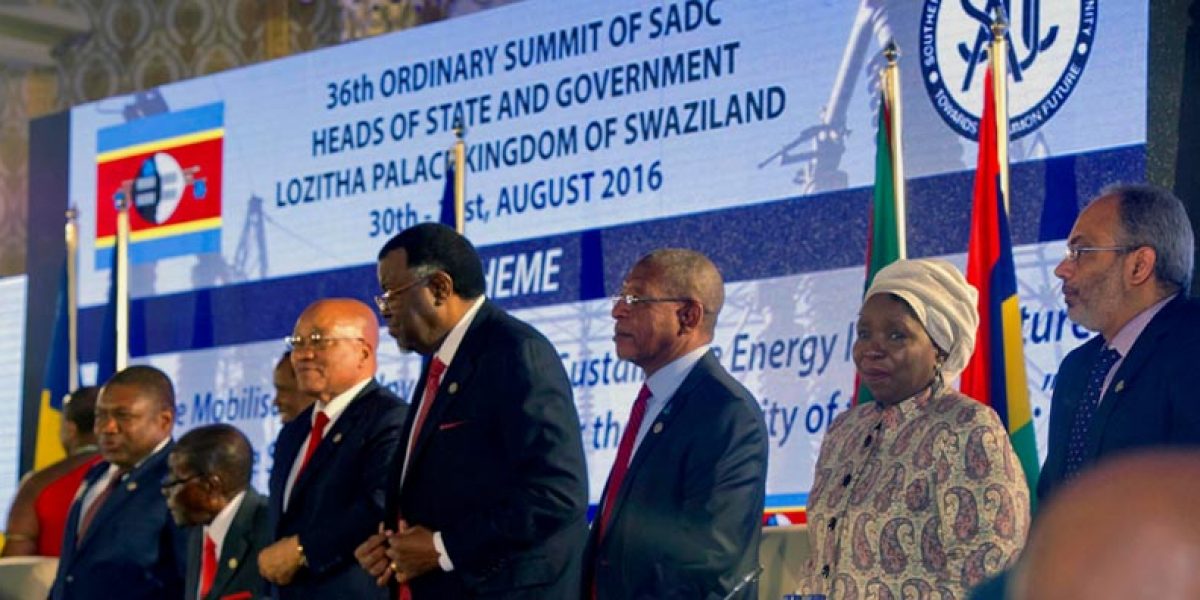The theme for their presidency was, ‘Towards an Innovative, Invigorated, Interconnected and Inclusive World Economy’, and the Summit Communique reiterates that the global economy can grow via innovation.
On the other side of the world, the Southern African Development Community (SADC) Summit took place in tiny Kingdom of Swaziland on the 30th of August; however, the focus was decidedly different. Although industrial development was also the topic of the meetings, the industrialisation hoped for in Southern Africa is still at a low level, targeting manufacturing and agriculture – no talks here of robots replacing labour but rather on how to involve more labour in production.
The SADC industrialisation plan is focused on facilitating investment, infrastructure development and regional value chains (RVCs), which will drive manufacturing in the region. Elsewhere in the world, RVCs are well established and talks are on how to upgrade within chains and how new technologies might disrupt the status quo.
With South Africa as the only G-20 nation from the African continent, African views are weakly represented within this forum. The outcomes of the two Summits show that the Southern Africa region is being left behind in global debates and South Africa is struggling to adequately represent the continent when faced with an agenda that has already moved beyond the realities of nascent economies in Southern Africa.
At the heart of SADC Summit discussions was the implementation of the Industrialisation Strategy and Roadmap. The Strategy highlights the importance of the formation of RVCs, which will allow SADC to pool resources, skills and market demand across the region in order to facilitate inclusive industrial development. Key sectors such as agro-processing and minerals are chosen for RVCs based on the competitive advantages of the region.
SADC held its first Industrialisation Week in Swaziland in parallel to the SADC Summit in order to provide input to the Ministers attending the Summit, in particular the Ministerial Task Force on Regional Integration. The Southern African Business Forum (SABF) working groups looked at the challenges and opportunities for implementing the RVCs highlighted in the strategy. The event particularly promoted private sector engagement in the discussions.
Throughout the world the private sector is not adequately consulted in policy decisions, such as industrialisation initiatives, which can only thrive with investment from the sector. The SABF therefore drew up recommendations on how to facilitate private sector involvement in RVCs. In the agro-processing sector, recommendations included soliciting private sector inputs before implementing regulations or subsidies and incentives in the region, informing and involving the private sector in SADC’s new Regional Agricultural Investment Plan, and involving the private sector in agricultural financing initiatives. The range of private sector actors that should be involved extends from the large agro-processing multinationals, to the banks which provide finance to the sector, to the SMEs that are the recipients of subsidies and government initiatives to stimulate agricultural development.
These recommendations aspire to minimise the gap between those who design policies and those who utilise them.
The South African Institute of International Affairs (SAIIA) has undertaken research to support SADC’s industrialisation efforts, including a Global/Regional Value Chain (GVRC) Repository website, which provides information on the opportunities and challenges for forming such chains in the region. SAIIA and the OECD have also interviewed firms throughout the region, which validates the recommendations from SADC’s Industrialisation Week. Most firms indicated that more outreach and communication from policymakers were necessary in order to support their investments in the region.
Despite the challenges of facilitating RVCs, positive developments in the region include progress on infrastructure projects. The SADC infrastructure working group narrowed down a myriad of projects to 5 key priority projects: the North-South Corridor Railway, the Harare-Chundu Road Link, the Beitbridge and Kasumbalesa border posts, the Beira Road/Rail and the Lusaka Dry Port.
Back to Hangzhou, the G-20 Declaration last week also recognised the need for industrialisation on the African continent with their ‘Initiative on Supporting Industrialisation in Africa’. The G-20 Communique emphasises strongly that industrialisation should be supported in Africa, but places this need firmly within the new industrialisation phase the world is entering. Particular attention is paid to the Digital Economy, again an area that Africa stands mostly outside of. A key area of concern for the promotion of ‘new’ industrialisation is the strong protection framework that needs to be in place for intellectual property rights, an area that has only been weekly developed with the SADC region. The communique also commits the G-20 to continue work on food security and development in line with the Sustainable Development Goals.
This focus on food security is where the two Summit outcomes converge somewhat. Africa is well placed to step up agricultural production, and new agricultural practices could be introduced via a partnership between G-20 nations and the continent.
SAIIA and the German Development Institute will be hosting the Think20 Africa Outreach in February 2017 under the German G-20 Presidency, which will be an ideal opportunity to cement mechanisms within the spread of G-20 dialogues to solicit and incorporate African views. This is essential for success, both within the G-20 and SADC’s industrialisation plans.








